Sotheby’s Judaica
Jewish Art has always been burdened by Jewish history. Unlike most other cultural traditions, the vicissitudes of fate have been particularly harsh and have frustrated any attempt to establish a long-standing cultural tradition for the Jewish people in their far-flung habitations. Frequently just as an art form began to take hold, an expulsion, pogrom, or oppressive decree would disrupt Jewish life and all chance of stability. Culture cannot be created on the run. Therefore simply as a matter of convenience much Jewish Art depended upon pre-existing forms and motifs from the surrounding culture. It has yielded the benefit of a well-worn mold into which Jewish content is poured. In spite of the danger of an admixture of foreign content in the inherited forms, Jewish Art has yielded many riches of aesthetic pleasure adding unexpected dimensions to non-Jewish form. This is evidenced by the highly discerning selection of artwork, some in traditionally Jewish forms and others not, currently on display at Sotheby’s in the current sale of “Important Judaica” shown between March 14 through the sale on March 18, 2004.
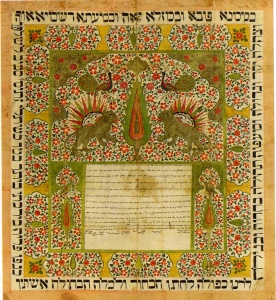
Sotheby’s has assembled in a collaborative effort from both its New York and Tel Aviv offices close to three hundred objects of exceptional quality. In what amounts to a museum style survey there are almost thirty ketubot from the seventeenth to nineteenth centuries. They represent a wide variety of styles from the far reaches of the Jewish Diaspora including: Lisbon, Gibraltar and Bucharest. Italy is well represented by the distinctive formats from Rome, Mantua, Florence, Lugo, Modena, Livorno, and Ancona. Additionally, there are distinctive ketubot from Iran, particularly Meshed and Isfahan. The very large (36 x 33) ketubah from Isfahan (1856) is a tour-de-force of delicate floral decoration surrounding an image of two rampant lions with rising suns (a symbol of the Isfahan community) and florid peacocks, all of which surrounds the actual text. The impressive size and bold execution of this ketubah expresses within the institution of marriage a fierce ethnic pride in the face of a frequently hostile Muslin majority.
Fifty Hanukah lamps compete as a historical survey of this art form in silver, pewter, and brass from Bohemia, Ukraine, Poland, Holland, Germany, Damascus, Palestine, Algeria, Morocco and India. The museum quality of the work is not surprising since many are from the collection of the Jewish Museum. The diversity of styles and invention from the eighteenth to twentieth century provide an excellent introduction to this distinctive Jewish art form.
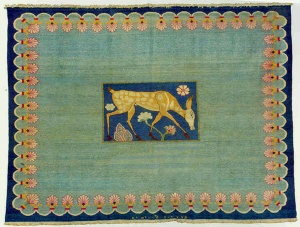
Shifting to non-Jewish art forms, a totally delightful surprise will greet all who discover the collection of three Marvadia carpets from Jerusalem. This workshop of craftsmen from the Bezalel School operated from 1920 until 1931 and produced carpets and rugs with a vibrant combination of Art Nouveau, Oriental and Judaic mosaic designs. The example in pale green with a stylized floral border that frames the central image of a spotted doe evokes the land of Israel, its fauna and flora in a masterpiece of pure poetry of textile design.
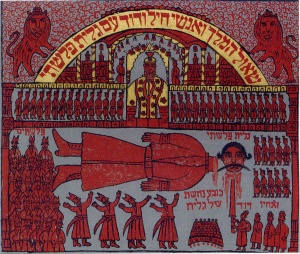
Reverse glass painting is a peripheral craft that Moshe ben Yiizach Mizrachi (1870-c. 1930) mastered and made his own unique form of expression. David Slaying Goliath, attributed to him, presents a folk image of incredible power. The prostrate body of the giant Goliath with his severed head at a right angle is the focus of seventy figures of assembled Philistines and Israelites. King Saul observes the scene that barely notices the heroic David. The rendition of this scene with contemporary figures serves as a jolting reminder to the Jewish audience of the all too recent oppressive rule of the Turks. The lurid blood red of the figures against the neutral gray background further enforces the precarious nature of living in the Land of Israel.
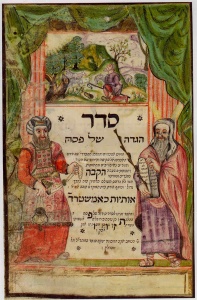
The exhibition boasts many important manuscripts, including the earliest example of Sefer Mizvot Gadol by Moses ben Jacob of Coucy from 1288 and a rare Mishneh Torah of the Rambam form 14th century Italy. Among these important handwritten works the Haggadah by the scribe and illuminator Yakov ben Yehudah Leib Shamash of Berlin from 1739 commands special attention.
After the invention of the printing press in 1455 the production of handwritten Haggadot declined precipitously as printed versions with woodblock and copperplate engravings became widely available. From the late 1600’s a rebirth of handwritten Haggadot occurred in Germany and Central Europe as economic times and security improved for the Jews. These works were commissioned for the wealthy Court Jews and were frequently given as luxurious wedding presents. The extremely popular printed edition of the Amsterdam Haggadah (1695) was used as a model for all the illustrations.
The images from the Amsterdam Haggadah were the most copied in history (see Yosef Hayim Yerushalmi) and yet it is ironic that they were all derived from a Swiss Christian artist, Mattaeus Merian. Where necessary, they were changed to suit the Haggadah, and yet the images bear the unmistakable imprint of a late Renaissance worldview. Our handwritten Haggadah from 1739 by Yakov ben Yehudah Leib Shamash used the exact same images with some very important differences.
His use of brilliant color is delicate and sensitive, lending a light and immediate touch to the subjects illuminated. The frontispiece has the traditional images of Moses and Aaron, transformed from the austere original figures to rather kindly depictions of recognizable Jews. Especially charming is the artist’s rendering of Moses at the burning bush removing his shoes. Moses is depicted as peasant shepherd kneeling on one knee, with one shoe prominently placed in front of him. He gazes with absolute simplicity and faith at the blinding light behind the bush, a totally convincing depiction of a supremely unreal event.
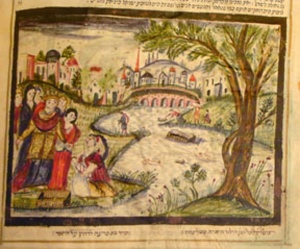
All of the illuminations have the same down-to-earth quality, rendering the distant historical narrative as easily understood contemporary events. Moses Rescued by Pharaoh’s Daughter is another example where the artist has transformed the original Renaissance images. The simplified rendering of the distant city and bridge (over the Nile) unifies the composition so that the image of the ark floating in the river with the infant Moses is immediately visible. In a compression of time, we simultaneously see the baby Moses presented to a shocked and worried Pharaoh’s daughter as other babies drown in the river behind her. The artist-scribe has clearly improved the original image, clarifying the event with stylistic simplicity that was impossible in the style of Christian Renaissance naturalism. Yakov ben Yehudah Leib Shamash redeemed this Haggadah’s images by breaking with Renaissance conventions.
In a similar and totally unexpected manner the five paintings by Isidor Kaufmann (1853-1921) break with another tradition. In the late nineteenth century Europe was dominated by two artistic movements. Impressionism and then post-Impressionism led the avant-garde towards the modernism of the twentieth century, while conservative tastes clung to the vestiges of Academic realism that was proving more and more irrelevant. Kaufmann, however clung to the realism of his native Vienna. From 1894 he specialized in depictions of the Jewish communities of Eastern Europe, concentrating on portraits of unnamed pious Jews that found a market among wealthy Viennese Jews. Two portraits shown are probably from drawings done of the same sitter, a dignified Chasid in a streimel, gazing at the viewer with unequaled intensity. The emerald green background intensifies his gaze. A portrait of a young Chasid posed before a Torah mantle renders another kind of intensity as the lad engages our eyes in what amounts to a visual assault. The overwhelming impression we get is of absolute integrity.
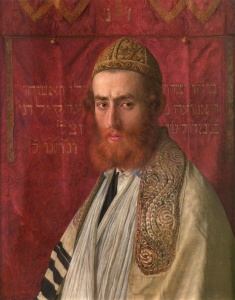
The real masterpiece of the exhibition is Kaufmann’s portrait of a red bearded Rabbi in front of a pale crimson Torah mantle. The rose colored background forms a flat visual field surrounding the unified shape of the pallid white tallis and kittel. His red beard fades into the background as we are engaged by his piercing eyes and the equally intense ornate tallis attara and skullcap. This is not academic realism we are witnessing, rather it is a radical application of modern compositional elements, stressing flatness and bold shapes in combination with the raw emotional power of the human face. Kaufmann, painting through the social and political upheavals of modernism and the First World War has found in the integrity of these pious Jews a modicum of stability in a world undergoing profound changes.
In the examples above Jewish artists have utilized existing non-Jewish forms, whether Haggadah illustrations or the conventions of academic realism, and have transformed them with creativity and a singular Jewish vision. Witnessing this process across the centuries provides a breathtaking pleasure in Sotheby’s current exhibition of Judaica that should not be missed.
Important Judaica
Sotheby’s
1344 York Avenue
New York, NY
www.sothebys.com